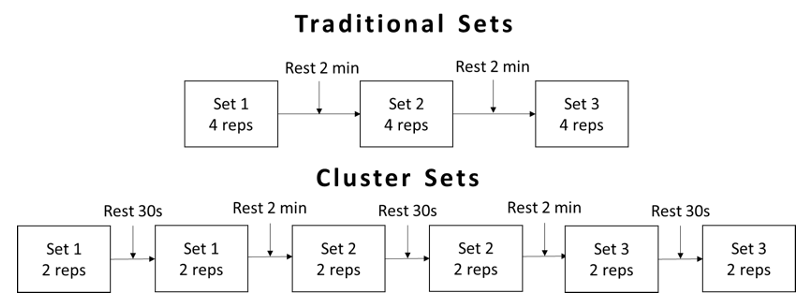
Strength coaches are continually looking for methods to enhance their training for their athletes. Enhancing training will mean different things to coaches, depending on their circumstances. Enhancing training could reduce the time in the weight room, increase the transfer of the weight room to field-based activities, or increase the strength outcomes from work already performed in the weight room. One tool in a coach’s toolbox to enhance their training is cluster sets. I’ve been using cluster sets for a few years in training both weightlifters and team sports athletes and spent a year researching how to optimize its application. Save yourself from diving deep down the cluster-set rabbit hole with this basic implementation blueprint.
What are Cluster Sets?
Cluster sets are a training methodology whereby a short period of rest is taken between repetitions within a set. Cluster sets have other names in practice, such as myo-reps and rest-pause sets. For simplicity's sake, a cluster set can refer to when the repetitions within a set are broken up by a short rest period. Instead of four sets of six reps, we will break those reps into “clusters” of two or three and take 15-30 seconds rest between each cluster. Figure 1 illustrates. Why would we want to do this? Cluster sets decrease the fatigue accumulated within a set. Accumulated fatigue will also cascade across a session, so we can reduce the net fatigue across the training session by using cluster sets.

One of the defining features of cluster sets is that small clusters are grouped, therefore separated by a long rest. This is a key differentiating feature of cluster sets instead of just using a lot of sets in a traditional structure. The key benefit here of using cluster sets is that of time management. One of my fundamental beliefs is that a good strength coach should be able to reap the maximum benefit in the least time possible, so the athletes can get back to doing what will win the game (skills).
RECENT: Touch as a Feedback Mechanism for Athletes
I think if I were to program a strength session of eight-12 sets of a single exercise with a three to five minutes break in between sets, you would get head coaches losing their hair, athletes getting bored—generally poor use of time. I think cluster sets provide an alternative to get a high density of quality, powerful reps, whilst not spending hours in the gym
Why Would a Coach Use (or Not Use) Cluster Sets?
Practically, if a coach is using cluster sets, there are four practical outcomes they could be looking for:
- Maintenance of velocity (and thus power).
- Decreased proximity to failure.
- Similar proximity to failure at a greater load.
- Maintenance of technique.
These four reasons for cluster sets occur due to the same mechanism, a relative reduction in fatigue. The decrease in fatigue makes sense as you are taking more rest. On the surface, this sounds great; fatigue is bad, right? Well, not always. Fatigue is important to stimulate the muscles to adapt. We need to train somewhat close to failure when training for maximal strength. Therefore, cluster sets may not be best when training for max strength. Every variable we change in the weight room will have a cause and effect, and nothing is always great for everything.
How Should We Implement Cluster Sets?
Cluster Sets for Absolute Strength (Max Effort)
Given that cluster sets reduce proximity to failure, I think it is questionable to use clusters when absolute strength is the desired training adaptation. Some studies have shown clusters are either equal or worse efficient than traditional strength exercises for absolute strength 1,2. This is due to the reduction in fatiguing metabolic by-products that may signal strength adaptations. Given the lack of evidence for cluster set use in absolute strength training, I tend to steer away from them if the load remains the same. If two training options have the same outcome, I will go for the more straightforward option ten times out of ten, and for absolute strength, this remains traditional sets.
However, there is a gap in the research in that cluster sets allow the coach to program slightly higher percentages for an athlete while maintaining a similar Rate of Perceived Effort (RPE). I think there is some potential application here. For example, three sets of six could reasonably be done at 80 percent 1RM. Three sets of 2+2+2 could be done closer to 85 percent while theoretically having a similar level of required exertion. Option two allows for increased repetitions to accumulate at a heavier weight, which may benefit advanced athletes. However, this would be a tough training block, and I think practitioners would need to exercise a large degree of judgment as to whether more load was actually required.
Cluster Sets for Power (Dynamic Effort)
Cluster sets come into their own when being used to train for increased power output. Power training involves training with submaximal loads with high movement velocity. Exercises like medball scoop tosses, accommodating resistance exercises, weightlifting derivatives, and plyometrics are common “power training” exercises. However, with multiple repetition sets, movement velocity, and therefore power output, will decrease. By utilizing cluster sets when training for power, we ensure that the latter repetitions within a set are performed at a similar movement velocity to the earlier reps. The maintenance of power, in turn, causes positive power adaptations.
When deciding on whether or not I want to use cluster sets for dynamic effort exercises, there are a few things I have to consider. For example, would there be a decline in velocity if the athlete performed the set in a traditional manner? Reductions in velocity will occur on a sliding scale relative to the load. For example, in my research, we found velocity in the hang power clean performed at 70 percent was greater in cluster sets from the fourth repetition onwards 3.
If I had only programmed sets of three, clusters would have been a bit of a waste of time. Different athletes, exercises, and set structures will all affect the velocity decrement characteristics. However, the core premise will remain; that cluster sets will only be useful if there would have been a reduction in power in a traditional set. So if you think an athlete needs more volume in their power training, cluster sets may facilitate more reps per set whilst not sacrificing movement velocity.
Cluster Sets for Hypertrophy (Repetition Effort)
Cluster sets can have application in hypertrophy training as they may facilitate greater accumulation of volume 4. This training style has been around for ages; even the old school 1x20 breath-pause sets are a variation of cluster sets. By taking small breaks between clusters, you can accumulate a greater number of reps. This is where the literature fails cluster sets a little bit because this is a very different set structure to those mentioned above. Using cluster sets for hypertrophy is about volume accumulation instead of maintaining velocity. The set structure looks different to allow for increasing volume. Total volume is one of the critical factors in hypertrophy, and therefore cluster sets may allow for greater accumulation of volume in a decreased space of time.
Practically, I find these to be useful for my clients who have a finite time to train and (in my opinion) need more training volume. By finite, I mean some of these clients may only be training for 20 minutes, so being as time-efficient as possible is essential. Outside of that, I haven’t come across too many situations where I have thought cluster sets were imperative for hypertrophy, as this method would be very fatiguing and overkill for many people.
Key Points
- Cluster sets are great for maintaining velocity throughout a set.
- Different types of cluster sets will have different outcomes, and each is a tool in the toolbox.
- My favorite use of cluster sets is maintaining high-quality, fast movements in dynamic effort exercises.
If you have any questions on cluster sets or strength training in general feel free to reach out on Instagram @dudley.charles or on twitter @CEP_Dudley.
References
- Hansen KT, Cronin JB, Pickering SL, Newton MJ. Does cluster loading enhance lower body power development in preseason preparation of elite rugby union players? The Journal of Strength & Conditioning Research. 2011;25(8):2118-2126.
- Lawton T, Cronin J, Drinkwater E, Lindsell R, Pyne D. The effect of continuous repetition training and intra-set rest training on bench press strength and power. J Sports Med Phys Fitness. 2004;44(4):361-367.
- Dudley CE, Drinkwater EJ, Feros SA. Different Cluster-Loading Protocols Have No Effect on Intraset and Interset Power Expression. The Journal of Strength & Conditioning Research. 2020.
- Krzysztofik M, Wilk M, Wojdała G, Gołaś A. Maximizing Muscle Hypertrophy: A Systematic Review of Advanced Resistance Training Techniques and Methods. International Journal of Environmental Research and Public Health. 2019;16(24):4897.
Charles Dudley is a performance coach based out of Beijing, China, and works for the Chinese Olympic Committee. He has previously worked privately as a strength and conditioning coach for several sports, such as rugby union, tennis, and hockey, in addition to coaching a number of national-level weightlifters. Charles has also been a tactical coach in rugby union and rugby 7s at the schoolboy and academy/elite pathway levels.










1 Comment